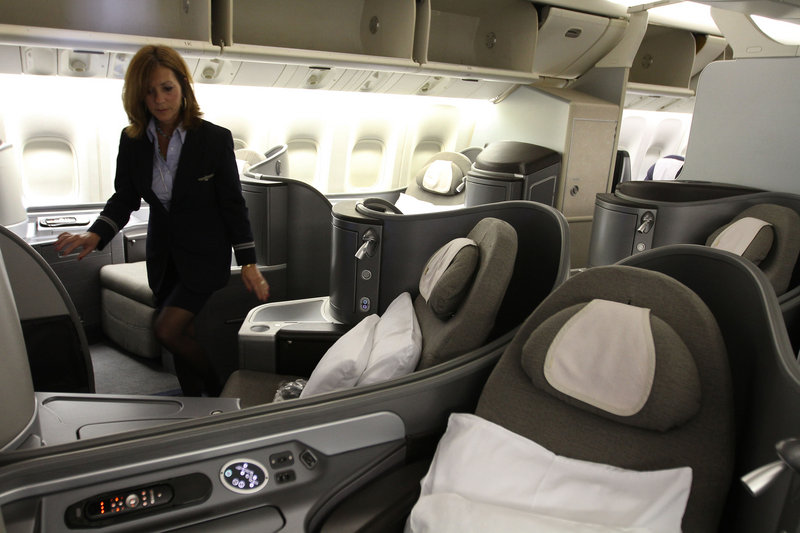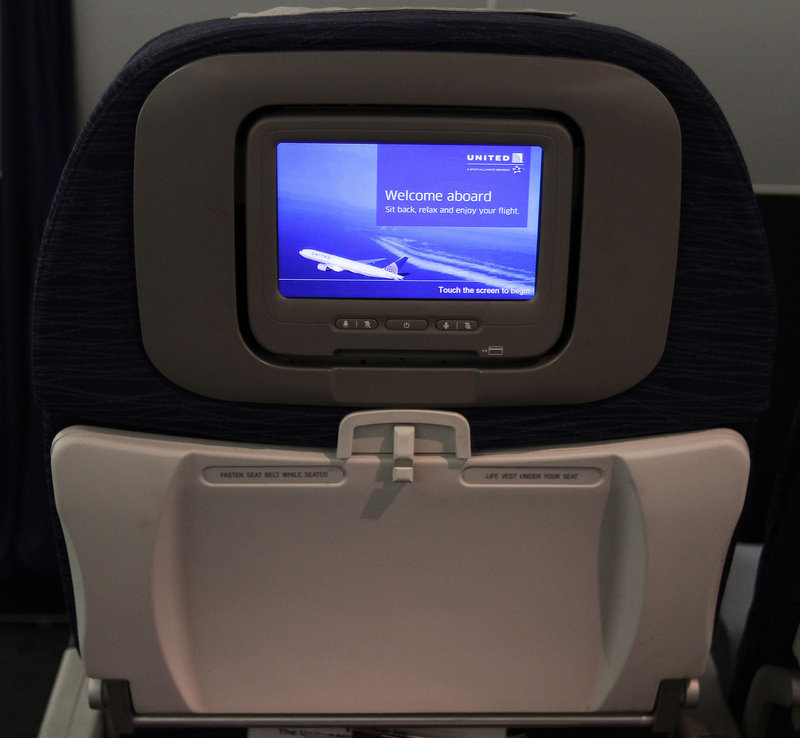CHICAGO – After decades of relatively little change, aircraft cabins in the United States are undergoing a renaissance that promises to make the flying experience more comfortable and enjoyable for passengers, especially for those at the front of the plane.
Major airlines are taking delivery of new airplanes with well-thought-out cabin amenities. At the same time, they’re spending hundreds of millions of dollars to upgrade the interiors of existing planes.
“We’ve seen in the last year or so some tremendous improvements in the passenger experience,” said Mary Kirby, editor-in-chief of Airline Passenger Experience magazine. “Airlines were rather stagnant for many years in terms of what they offered.”
Some seats on long flights will recline into flat beds. Some overhead bins will be better-designed and larger. Seats will have on-demand movies and television, in addition to power outlets. Cabins will be equipped with wireless Internet access and mood lighting.
And, yes, some seats on these new and updated planes will have more legroom.
But airline executives facing stiff competition and high fuel costs are not making pricey changes out of benevolence. The best goodies are reserved for passengers toward the front of the plane, sanctuary for travelers willing to pay more or those with elite frequent-flier status.
“This really boils down to a desire to win high-value customers,” said Rob Friedman, American Airlines vice president of marketing, referring to his airline’s attempt to woo mostly frequent-flying business travelers.
Upgrades in some cases mean economy-class, believe it or not, will become more cramped. Fortunately, some in-cabin perks will trickle back to coach to distract attention from snug confines.
Personal space is the most coveted of passenger amenities — and the most expensive.
“What people care first and foremost about is getting the best possible price, and then they want to make sure that when they stand up from their airplane ride they can still feel their knees,” said Henry Harteveldt, a travel industry analyst with Atmosphere Research Group.
An aircraft fuselage has only so many square feet, so seat configuration is a zero-sum puzzle. If an airline gives more space in one section, it must recover it from somewhere else or forego revenue by removing seats.
“Airlines personify the saying ‘robbing Peter to pay Paul,’” Harteveldt said. “If Paul wants more legroom, Peter is going to have less.”
Many airlines now allow you to pay for more legroom. United Airlines was the pioneer and calls it Economy Plus. American calls it Main Cabin Extra, Delta Air Lines calls it Economy Comfort, and JetBlue Airways calls it Even More Space.
In reality, this new class of seat is what business class used to be.
“Legroom is clearly what people value,” said Joe Brancatelli, a business-travel writer and editor of JoeSentMe.com. “They want it for free, of course, but they will pay for it.”
Many airlines are eliminating traditional first class.
“Business class has become so elaborate, you don’t need first class anymore,” Brancatelli said.
The ultimate in legroom is lying down. For international and some coast-to-coast domestic flights, airlines are adding seats that recline into beds. Early versions had the head somewhat elevated, but the new standard is full-flat seats that recline parallel with the cabin floor.
“Now, the cost of doing business for long-haul business class is fully flat seats, and we’re seeing that across the board,” Kirby said.
After eliminating many economy-class services, such as free food and free checked bags, some U.S. airlines are squeezing even more from coach, further reducing legroom as they install more chairs or yield the space to higher-paying customers.
“Everybody’s upgrading their business-class cabins, but it’s coming at the expense of coach,” Brancatelli said.
For example, American’s refresh of its two-aisle Boeing 777s will squeeze in another seat across coach, going from its current nine seats wide to 10. United’s new Boeing 787 Dreamliner will have nine seats across, compared with two Japanese airlines that already use the plane configured with eight seats across.
Southwest’s new planes will have thinner seats but will add another row. That means legroom, which is called seat pitch in the business, will go from 32 inches to 31. And seats will recline 2 inches instead of 3.
In August, United confirmed that it, too, will switch to slimmer seats on its narrow-body Airbus planes. The changeover, which will allow it to add a row of seats, begins next year.
Thinner seats have received mixed reviews among passengers at European airlines, which were first to adopt them, Kirby said. But Kirby recently flew such a seat on Lufthansa and described it as “rather comfortable.”
“I was pretty impressed in terms of what they were able to do in terms of carving out space for knees and shins,” she said. “I think most people won’t notice.”
JetBlue Airways and WestJet in August said they will add more legroom for those willing to pay extra at the expense of back-of-the-bus passengers who will be slightly more cramped as a result.
Perhaps losing a few cubic inches here or there wouldn’t matter as much if you were likely to have an empty seat next to you, so you can spread out. But that is decidedly unlikely. U.S. airlines, as a business strategy, are flying much fuller planes nowadays, which means fewer empty seats for elbow room.
As people carry more mobile devices and expect to be constantly connected — even flying isn’t the refuge from the office it once was — airlines are adding wireless Internet and standard power outlets in the seat to keep those devices functioning at 30,000 feet. For those off the clock, airlines are offering on-demand movies and television, usually for an extra charge.
The good news is that many of the technology upgrades are available in coach too.
“All this in-flight entertainment and connectivity give the airlines the ability to distract passengers’ brains from the pain of being in these ultra-snug seat pitches in economy class,” Kirby said.
Send questions/comments to the editors.




Success. Please wait for the page to reload. If the page does not reload within 5 seconds, please refresh the page.
Enter your email and password to access comments.
Hi, to comment on stories you must . This profile is in addition to your subscription and website login.
Already have a commenting profile? .
Invalid username/password.
Please check your email to confirm and complete your registration.
Only subscribers are eligible to post comments. Please subscribe or login first for digital access. Here’s why.
Use the form below to reset your password. When you've submitted your account email, we will send an email with a reset code.